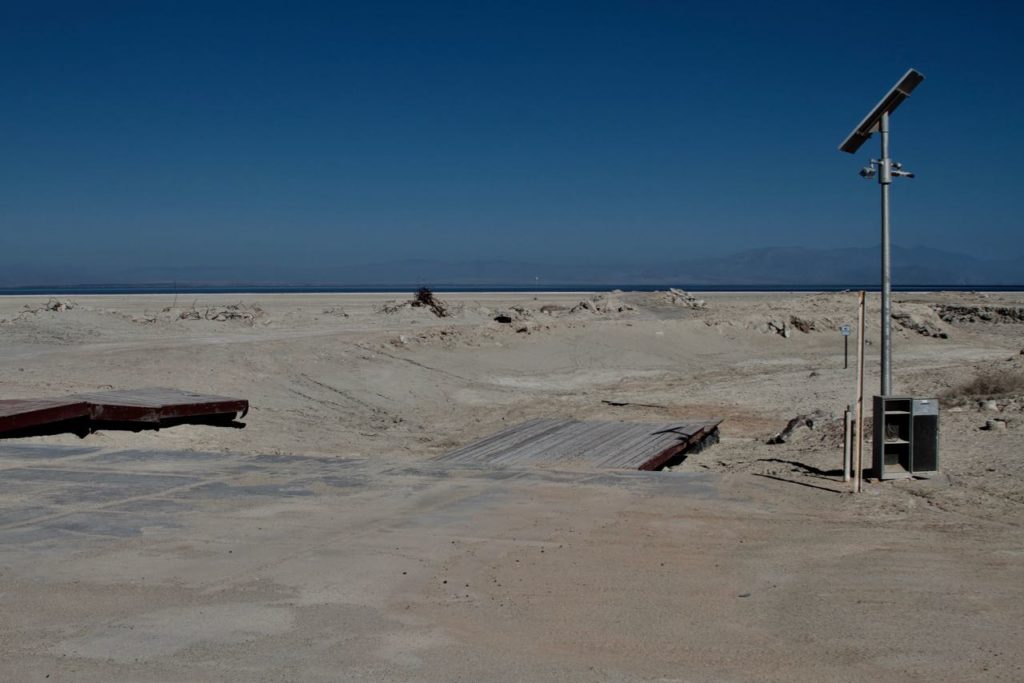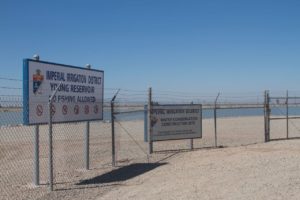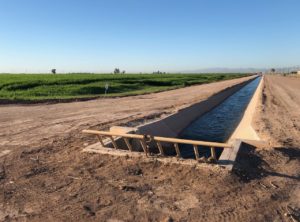
Red Hill Bay boat ramp, Salton Sea, Imperial County, California. June 2019
RED HILL BAY – I couldn’t resist the “abandoned boat ramp” trope when I visited the Salton Sea this week. No amount of channel dredging is going to get you to the Sea at this point. And all that recently exposed shoreline between the old boat ramp where I was standing when I took the picture and the Sea off in the distance represents a source of dangerous dust.
Conserve water on the farms of the Imperial Valley, and you reduce tail water flowing to the Salton Sea, which shrinks when evaporation is greater than inflows. When the wind whips up from the south, this place can be unbearable. We cannot address the Colorado River’s problems without addressing that dust.
Imperial is a remarkable place, half a million acres of desert with a lattice of irrigation canals draped across it that has turned it into some of the most productive farmland in the United States. More than 40 miles from north to south at its longest, and nearly 30 miles east to west at its widest, it is a bustle of farming, even in the heat of summer.
The cultural and institutional nature of that lattice of irrigation canals makes Imperial one of the most water-aware communities you’ll find anywhere. Lots of communities are deeply connected to the Colorado River, but Imperial has a unique self-awareness about its relationship with the river that is fascinating.
My trip to the Lower Colorado this week coincided with Tuesday’s meeting of the Imperial Irrigation District Board of Directors, which as a longtime student of local government I found fascinating.
Folks from around the valley gathered for the ceremonial handing out of checks from the irrigation district to help fund local community pools. Dippy Duck, the district’s canal safety mascot, was on hand.

Dippy Duck and friends
I’m told Dippy is a big deal here.
The deputy general manager of the San Diego County Water Authority gave a presentation about a study his agency is launching to consider the feasibility of connecting a pipe from San Diego to Imperial’s system to move conserved farm water to the coastal city. (Wait, what? Ry Rivard has done the heavy lifting on this one. I don’t have much to add other.)
But to me, the most fascinating discussion involved 25 acres of currently unfarmed, unirrigated land that an Imperial farmer wants to turn into an olive orchard.
The farmer had filed a “petition for inclusion”, which would have brought the land within the district’s Imperial Unit boundary, making it eligible for water from the district’s Westside Main Canal. This was 25 acres in a district that’s half a million acres large. But however small the acreage, the discussion captured the tension between two important but seemingly irreconcilable positions: the importance of using water to irrigate land to support the community’s economy versus the reality, as the IID staff report on the issue noted, of “the ongoing 19-year drought on the Colorado River.”

Young Reservoir, Imperial Irrigation District
Tina Shields and Mike Pacheco, the Imperial Irrigation District’s water managers, gave me a great tour of the district yesterday. In addition to Red Hill Bay to talk about a proposed restoration site there (more on that in a moment) we stopped by Young Reservoir. On the scale of the Colorado River, Young is tiny – less than 50 acres of surface area, a 275 acre foot capacity. But in terms of institutions and policy, it is huge. In 1989, IID and the Metropolitan Water District of Southern California, the nation’s large municipal water wholesaler, signed an agreement through which Met paid for efficiency improvements in IID’s system in return for the saved water. A newly built interceptor catches tail water flowing out the ends of 11 laterals (about 31,000 acres worth of farmland) and pumps it to Young, from which it can be returned to IID’s Vail Canal and used by farmers. Had it not been caught, it would have simply flowed into the Salton Sea.
But that’s the thing, right? It would have flowed into the Salton Sea. Enough conservation efforts like this (and there have been many, and there could be many more) and we reduce inflows to the Sea to leave places like Red Hill Bay stranded, and the many thousands of acres of newly surfaced shoreline vulnerable to the desert winds. Out at Red Hill Bay, we’re about to see a few hundred acres of habitat restoration, which will cover a significant area of dust source. But it’s a drop in the bucket compared to the work that needs to be done.
Imperial Irrigation District is the largest water user in the Colorado River Basin. Any effort to roll back Colorado River water use to live with hydrologic reality will be very difficult without Imperial’s help.
We have to deal with the Salton Sea problem.


that’s the first time I heard and thought of dust as a river/water/flood problem. I always thought of dust as aeolian.
The Sea was an unnatural accident of man and now we’re trying to keep an unnatural situation continuing. Is there any conversation about letting it go back to pre-19xx habitat (before the big flood)? Of course, dust and other pollution mitigation would need to be done, perhaps bringing back native flora, or planting other ground cover, etc?
Per Chris Gilbert, of course you can “address” the Colorado’s problems without addressing the Salton Sea.
Confusing “can” and “should” is always bad moral philosophy.
That said, “should” we? Not if cheaper alternatives exist, first. The people who live there can move as needed.
After all, we didn’t use the housing bubble bursting to get 5 million people to move out of Southwestern cities and back to Des Moines and St. Louis.
Pingback: From Inkstain: You can’t address the Colorado River Basin’s problems without addressing the Salton Sea – Salton Sea Saw
If you all haven’t viewed this documentary, it’s worthwhile: Plagues and Pleasures on the Salton Sea
PBS’s ‘TrulyCA’ series.
https://www.google.com/url?sa=t&rct=j&q=&esrc=s&source=web&cd=1&cad=rja&uact=8&ved=2ahUKEwiX-Ifo8_riAhXxGDQIHVSDAcYQtwIwAHoECB4QAQ&url=https%3A%2F%2Fwww.pbs.org%2Fvideo%2Ftruly-ca-plagues-pleasures-salton-sea-episode-302-trulyca%2F&usg=AOvVaw3ySvPeT2IA1hAayulw6VjQ
Here’s the entry on it in Wikipedia:
https://en.wikipedia.org/wiki/Plagues_%26_Pleasures_on_the_Salton_Sea)
Some veterans of the Colorado River Basin have said, “What happens in Sacramento affects Denver, Phoenix, Las Vegas…etc.” It might be worth adding that “whatever happens in the Imperial Valley affects the rest of the Basin.” The Law of the River isn’t changing anytime soon. And guess what, a water user with a senior water entitlement to over 3 million acre-feet (that’s more water than Arizona and Nevada’s allocation combined) matters. That’s IID.
They pay attention too- “They (IID) really are interested in keeping track of what’s going
on. They think that if they don’t keep an eye on it, they will be thrown under the bus.” (Bill Swan Interview, June 4, 2007. CAP Oral Histories Project.)
This will be the superfund site of superfund sites. An accidental sea that is drying up because of conservation due to an ongoing structural deficit of water. LA, San Diego, Yuma and Phoenix are going to love their air quality in the near future.